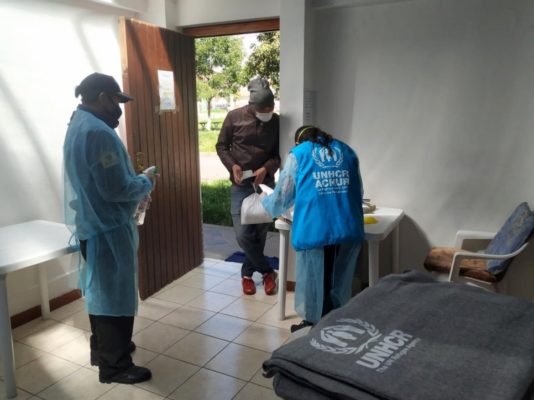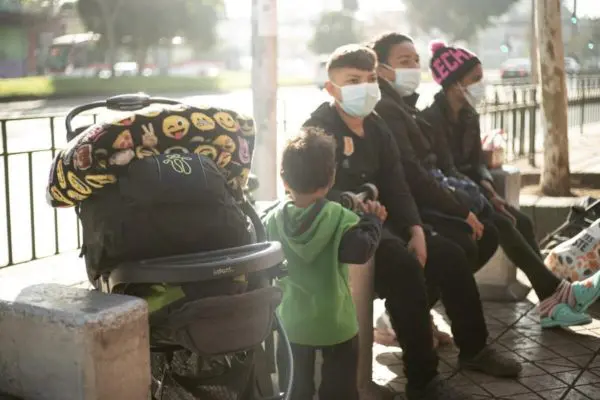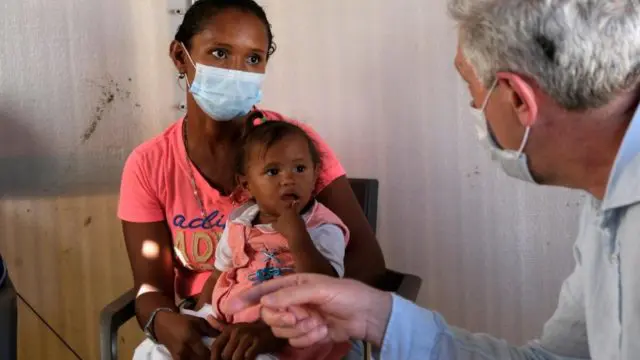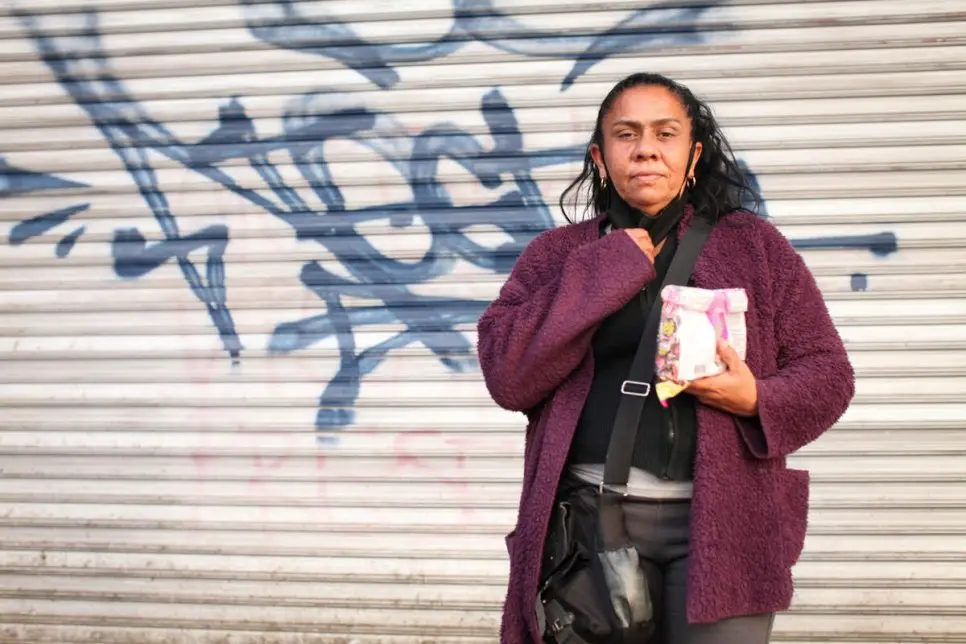
Living on the streets of Santiago, Wendy and her family dread the coming winter. © UNHCR/Marcelo Albornoz Riesco
In the southern half of South America, plummeting temperatures bring additional hardships for those living on the streets, adding to the misery brought on by the coronavirus pandemic.
By Stephanie Rabi Misle in Santiago, Chile
The cold is already like nothing Wendy* has ever experienced. The 52-year-old grandmother and her family are living on the streets of the Chilean capital, Santiago, after having fled their native Venezuela, a tropical country where the temperature rarely drops below 20°C.
But since fleeing to South America’s southern-most nation, the family has had to grapple with chilly conditions for the first time. The looming Southern Hemisphere winter regularly brings sub-zero temperatures to Santiago, and Wendy and her family worry about how they will protect themselves from the elements over the next several months.
“I don’t have the words to describe how cold it is in Santiago.”
“I don’t even have the words to describe how cold it is here in Santiago,” said Wendy. “And people tell me that the real cold hasn’t even begun yet.”
DONATE TO SUPPORT VENEZUELAN REFUGEES
Unable to afford a place to live, Wendy, her husband, their son, daughter-in-law and one-year-old grandson have been sleeping under a makeshift tent they put together nightly by draping a blanket over a bench and sleeping cheek-by-jowl beneath it, on flattened cardboard. They use their bags as pillows, in part to prevent them from being snatched away during the night.
“We need blankets, we need warm clothing, warm footwear…we need everything, really. We have nothing,” Wendy said with a sigh, adding that the cold is taking a physical toll on her. “I’m no longer 15 years old, so it really affects me…. My joints hurt, and I’m all swollen.”
Wendy and her family are not alone. Many of the more than 5 million Venezuelans who have fled widespread food and medicine shortages and spiralling insecurity back home have taken refuge in Andean countries such as Colombia and Peru, as well as the extreme southern nations of Argentina and Chile, where the cold can be bracing. The onset of Southern Hemisphere winter threatens to compound the devastating effects of the COVID-19 pandemic, which has hit Latin America particularly hard and continues to rage throughout much of the region. The combination of the coronavirus and winter weather pose a direct threat to Venezuelan refugees and migrants across many parts of South America.
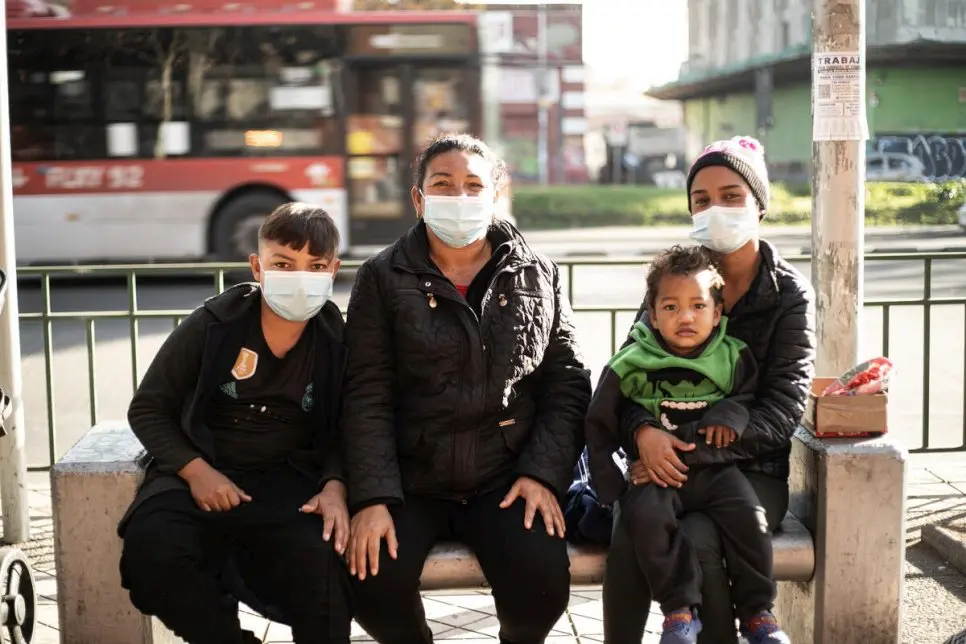
Yamileth, in the knit cap, and her family experienced cold weather for the first time during their long journey to Chile. © UNHCR/Yhan Cancino
Yamileth* and her family endured the cold on multiple occasions during their arduous, south-bound journey from Venezuela’s sweltering petroleum capital, Maracaibo, to Chile.
“The cold in Ecuador was too much. My child started to get hypothermia and began to vomit because of the cold,” recalled the 20-year-old mother, who made the trip with her 2-year-old son and her brother, mother and the mother’s partner, defying coronavirus-related border closures in some places. The family faced even colder weather when they arrived in the Chilean border town of Colchane. “At night, the cold was so extreme that the sheets were covered in ice.”
After over two weeks in Colchane, where they slept on the streets or in gas stations, huddling together to keep warm, the family managed to scrape together enough money to buy bus tickets for the more than 2,100-kilometer-long trip to Santiago.
Subscribe to UNHCR’s mailing list
But finally arriving in their destination has not improved their situation. They still often have no choice but to sleep on the streets. They get by on the sale of candies to passers-by, but most days fail to sell enough for a hotel room for the night. Plus, homelessness has its hidden costs: the family must pay to use a bathroom and to have someone watch their meagre possessions while they are out peddling their wares.
“This cold can actually kill.”
Across the region, UNHCR, the UN Refugee Agency, is ramping up its efforts to help Venezuelans through the winter. In Chile, which is home to an estimated 460,000 Venezuelan refugees and migrants, UNHCR is distributing winter kits and thermal blankets, as well as cash assistance and electronic vouchers so those in need can buy heaters, fuel and winter clothes. Winter kits will also be distributed in Argentina, Bolivia and Uruguay. In Peru, where winter arrived ahead of schedule this year, blanketing such high-altitude cities as Cuzco and Arequipa with more than 15 centimetres of snow, UNHCR is working with Venezuelan volunteer brigades to reach the most vulnerable, including Peruvian indigenous communities. While most of Brazil is tropical – with parts of the Amazon region recently hit by historic floods – the south of the country can get very cold during winter. UNHCR is aiming to raise funds to distribute warm clothes to Venezuelan refugees and migrants there.
Wendy, the grandmother in Santiago who sleeps beneath the jerry-rigged tent, said she is frightened to think about just how cold it will get this winter.
“This cold can actually kill,” she said.
*Last names not included for protection reasons.
Originally published by UNHCR on 9 June 2021.



